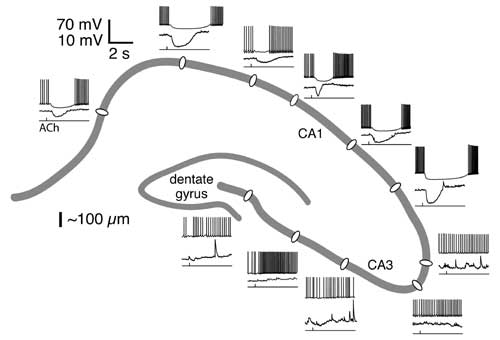Gulledge AT, Kawaguchi Y (2007) Phasic cholinergic signaling in the hippocampus: functional homology with the neocortex? Hippocampus 17, 327-332.
Acetylcholine (ACh) acts as a neurotransmitter in both the hippocampus and neocortex to facilitate learning, memory, and cognitive function. Here we show that transient muscarinic ACh receptor (mAChR) activation inhibits action potential generation in CA1, but not CA3, pyramidal neurons via activation of an SK-type calcium-activated potassium conductance. Hyperpolarizing responses generated by focal ACh application near the somata of CA1 pyramidal neurons were blocked by atropine or the M1-like mAChR antagonist pirenzepine, but not by the M2-like mAChR antagonist methoctramine. Inhibitory cholinergic responses required intracellular calcium signalling, as evidenced by their sensitivity to depletion of internal calcium stores or internal calcium chelation. Cholinergic inhibition did not require GABAergic synaptic transmission, but was blocked by apamin, an SK channel antagonist. In contrast to inhibitory effects in CA1 neurons, ACh was primarily depolarizing and enhanced action potential firing in CA3 pyramidal neurons. These results, when combined with recent data in neocortical neurons, suggest a functional homology in phasic cholinergic signalling in the hippocampus and neocortex whereby ACh preferentially inhibits those neurons in the lower cortical layers (CA1 and layer 5 neurons) that provide the majority of extracortical efferent projections.
